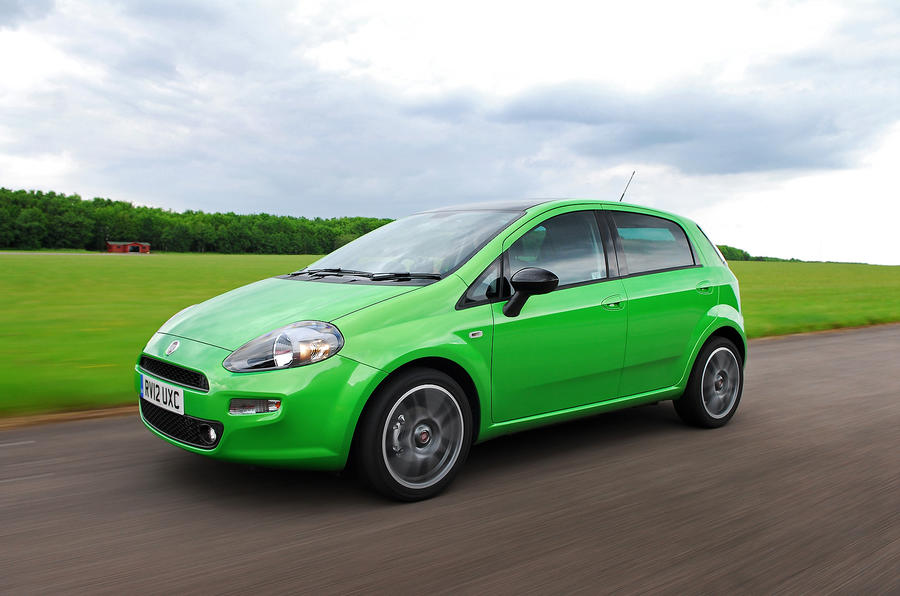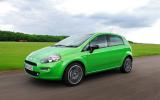What is it?
Concerned that its buyers may have their heads turned by younger models, Fiat has treated the venerable Punto to a very gentle mid life makeover (which you probably won’t notice) and added two new engines (which you certainly will).
One is an evolution of the MultiJet diesel engine which extracts 83bhp from 1300cc, and emits just 90g/km CO2, but the other, which we’ll focus on here, is the turbocharged version of Fiat’s two-cylinder TwinAir petrol motor.
Making its debut in the Punto, the award-winning powerplant also pulls 83bhp from its hat, along with 107lb ft of torque at 2000rpm, but the real party trick is the diesel-rivalling 67.3mpg and 98g/km CO2.
Those figures are unchanged from the engine’s appearances in the 500 and the stellar new Panda, but elsewhere several changes have been made, partly in deference to the higher quality expected of a B segment model.
In the Punto the TwinAir is mated to a six-speed manual gearbox rather than the five-speeder found in its smaller stablemates, and in the interests of greater refinement, it has been fitted with a dual mass flywheel and balancing countershaft.
What's it like?
Thanks to its microscopic proportions, there’s always an element of incredulity that a TwinAir-equipped car functions at all, let alone does so with modest potency. The Punto is not a heavy supermini, but 1075kg is still a considerable tortoise shell to carry around and it’s a tribute to Fiat’s ingenuity that the engine - probably helped by the extra ratio - retains a modicum of flexibility in high gear.
Nevertheless, the temptation to rev the tiny two-pot into the upper echelons of its whiny thrum remains. Mechanical modifications may have smoothed away some of the vibrations, but the TwinAir unit still sounds like a chainsaw being held under a pillow on the floor below. It’s just as easy to wind up too; pay too little attention and every gear will be ushered swiftly into its soft limiter.
What it does not do, however, is resonate as much fun. The already cute-as-a-button 500 suited its blustery pluck, but in the lardier Punto it’s like throwing punches under water - all effort and no real impact. The alternative is to obey the nannying gearshift indicator and make a play for hyper-mile economy. The slower pace suits Fiat’s supermini - its dynamic temperament is roughly the equivalent of a fat puppy running on wet grass – and with so much weight removed from its nose, it lolly gaggles over bumps like it’s about to float away. The effect is not unwelcome after one too many firmly nailed down superminis, and chances are you’ll never pick up enough speed to encounter the poorly contained body roll, but doing what the TwinAir wants is a copper-bottomed way of placing its headline issue front and centre.
Even with our lead feet substituted for sensible shoes, we couldn’t better 45mpg on a half hour journey despite being propped for long periods at the national limit. Arguably that’s not a shameful figure (doubtless others could do better - we lacked the saint-like patience required to repeatedly depress the torque-sapping Eco button) but if you’re expecting oil burning mpg from your green Punto, you’ll likely be disappointed.
Should I buy one?
If you’re allergic to diesel prices, don’t expect to do mammoth miles and don’t burst a blood vessel if your car fails to measure up to its claimed economy figures, then the TwinAir might appeal. But, more often than not, the aged supermini feels like a model too far for Fiat’s diminutive engine.













Join the debate
Add your comment
replacement??
The Punto is seriously long-in-the-tooth, it needs to be replaced soon...then theres that colour? eeew!
Dual Mass Flywheel?
A supermini should be simple, tough and cheap to repair when it goes wrong. I fear this TwinAir, as good as it is in the Panda and 500, is too complicated for its own good. Give me the 1.2 FIRE engine any day.
Looks like another engine
Looks like another engine pulling every trick in the book to beat the official test, but can't cut it in reality. don't manufacturers realise that this will put off purchasers so much they are unlikely to ever return to the brand?